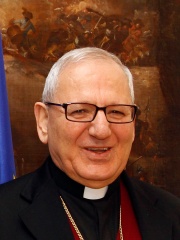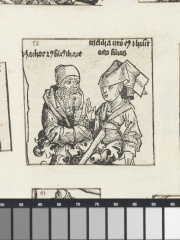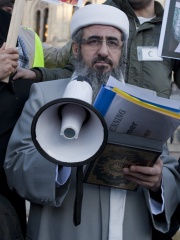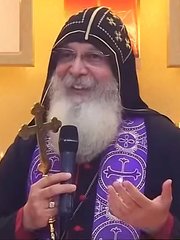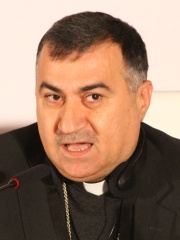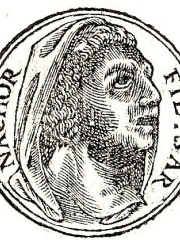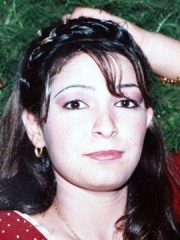
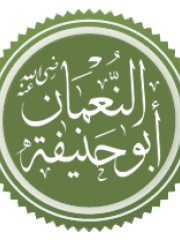
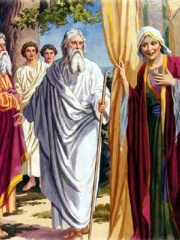
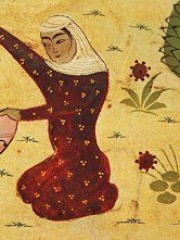
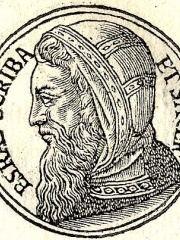
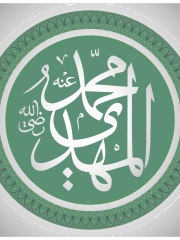
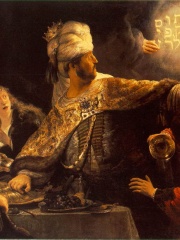

The Most Famous
RELIGIOUS FIGURES from Iraq
This page contains a list of the greatest Iraqi Religious Figures. The pantheon dataset contains 3,187 Religious Figures, 42 of which were born in Iraq. This makes Iraq the birth place of the 15th most number of Religious Figures behind Greece, and Russia.
Top 10
The following people are considered by Pantheon to be the top 10 most legendary Iraqi Religious Figures of all time. This list of famous Iraqi Religious Figures is sorted by HPI (Historical Popularity Index), a metric that aggregates information on a biography's online popularity. Visit the rankings page to view the entire list of Iraqi Religious Figures.

1. Abraham (1813 BC - 1638 BC)
With an HPI of 89.99, Abraham is the most famous Iraqi Religious Figure. His biography has been translated into 170 different languages on wikipedia.
Abraham (originally Abram) is the common Hebrew patriarch of the Abrahamic religions, including Judaism, Christianity, and Islam. In Judaism, he is the founding father who began the covenantal relationship between the Jewish people and God; in Christianity, he is the spiritual progenitor of all believers, whether Jewish or non-Jewish; and in Islam, he is a link in the chain of Islamic prophets that begins with Adam and culminates in Muhammad. Abraham is also revered in other Abrahamic religions such as the Baháʼí Faith and the Druze faith. The story of the life of Abraham, as told in the narrative of the Book of Genesis in the Hebrew Bible, revolves around the themes of posterity and land. He is said to have been called by God to leave the house of his father Terah and settle in the land of Canaan, which God now promises to Abraham and his progeny. This promise is subsequently inherited by Isaac, Abraham's son by his wife Sarah, while Isaac's half-brother Ishmael is also promised that he will be the founder of a great nation. Abraham purchases a tomb (the Cave of the Patriarchs) at Hebron to be Sarah's grave, thus establishing his right to the land; and, in the second generation, his heir Isaac is married to a woman from his own kin to earn his parents' approval. Abraham later marries Keturah and has six more sons; but, on his death, when he is buried beside Sarah, it is Isaac who receives "all Abraham's goods" while the other sons receive only "gifts". Most scholars view the patriarchal age, along with the Exodus and the period of the biblical judges, as a late literary construct that does not relate to any particular historical era. It is largely concluded that the Torah, the series of books that includes Genesis, was composed during the Persian period, as a result of tensions between Jewish landowners who had stayed in Judah during the Babylonian captivity and traced their right to the land through their "father Abraham", and the returning exiles who based their counterclaim on Moses and the Exodus tradition of the Israelites.

2. Abu Hanifa (698 - 767)
With an HPI of 83.39, Abu Hanifa is the 2nd most famous Iraqi Religious Figure. His biography has been translated into 77 different languages.
Abu Hanifa (Arabic: أَبُو حَنِيفَة, romanized: Abū Ḥanīfa; 5 September 699 CE – 18 June 767 CE) was a Muslim scholar, jurist, theologian, ascetic, and eponym of the Hanafi school of Sunni jurisprudence, which remains the most widely practiced to this day. His school predominates in Central and South Asia, Turkey, Africa, the Balkans, Russia, and some parts of the Arab world. Sources disagree on exactly where he was born, whether in Kufa (held by the majority), Kabul, Anbar, Nasa or Termez. Abu Hanifa traveled to the Hejaz region of Arabia in his youth, where he studied in the Islamic holy cities of Mecca and Medina. He was named by al-Dhahabi as "one of the geniuses of the sons of Adam" who "combined jurisprudence, worship, scrupulousness, and generosity". As his career as a jurist and theologian progressed, he became known for favoring the use of reason in his jurisprudential rulings, and even in his theology. His school grew after his death, and the majority of its followers would also eventually come to follow the Maturidi school of theology. He left behind two major students, Abu Yusuf and Muhammad al-Shaybani, who would later become celebrated jurists in their own right.

3. Sarah (1803 BC - 1676 BC)
With an HPI of 79.84, Sarah is the 3rd most famous Iraqi Religious Figure. Her biography has been translated into 73 different languages.
Sarah (originally Sarai) is a biblical matriarch, prophet, and major figure in Abrahamic religions. While different Abrahamic faiths portray her differently, Judaism, Christianity, and Islam all depict her character similarly, as that of a pious woman, renowned for her hospitality and beauty, the wife of Abraham, and the mother of Isaac. Sarah has her feast day on 1 September in the Catholic Church, 19 August in the Coptic Orthodox Church, 20 January in the LCMS, and 12 and 20 December in the Eastern Orthodox Church.

4. Rabia of Basra (710 - 801)
With an HPI of 78.81, Rabia of Basra is the 4th most famous Iraqi Religious Figure. Her biography has been translated into 53 different languages.
Rābiʼa al-ʼAdawiyya al-Qaysiyya (Arabic: رابعة العدوية القيسية; c. 716 – 801 CE) or Rabia Basri was a poet, one of the earliest Sufi mystics and an influential religious figure from Iraq. She is regarded as one of the three preeminent Qalandars of the world.
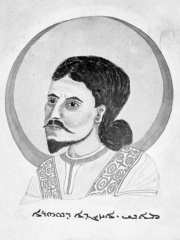
5. Mani (216 - 274)
With an HPI of 78.43, Mani is the 5th most famous Iraqi Religious Figure. His biography has been translated into 69 different languages.
Mani (; c. April AD 216 – 2 March AD 274 or 26 February AD 277) was an Iranian prophet and the founder of Manichaeism, a religion most prevalent in late antiquity. Mani was born in or near Ctesiphon (south of modern Baghdad) in Mesopotamia, at the time part of the Parthian Empire. Seven of his major works were written in Syriac, and the eighth, dedicated to the Sasanian emperor Shapur I, was written in Middle Persian. He died shortly after being imprisoned by Bahram I in Gundeshapur.

6. Ezra (500 BC - 401 BC)
With an HPI of 77.65, Ezra is the 6th most famous Iraqi Religious Figure. His biography has been translated into 55 different languages.
Ezra (fl. fifth or fourth century BCE) is the main character of the Book of Ezra. According to the Hebrew Bible, he was an important Jewish scribe (sofer) and priest (kohen) in the early Second Temple period. In the Greek Septuagint, the name is rendered as Ésdrās (Ἔσδρας), from which the Latin name Esdras comes. His name is probably a shortened Aramaic translation of the Hebrew name עזריהו (Azaryahu), meaning "Yah helps". In the Hebrew Bible, or the Christian Old Testament, Ezra is an important figure in the books of Ezra and Nehemiah, which he is traditionally held to have written and edited, respectively. According to tradition, Ezra was also the author of the Books of Chronicles and the Book of Malachi. He is depicted as instrumental in restoring the Jewish scriptures and religion to the people after the return from the Babylonian Captivity and is a highly respected figure in Judaism. He is regarded as a saint in the Roman Catholic Church, which sets his feast day as July 13, the same as that of his contemporary, Nehemiah. He is also venerated as a saint in the Eastern Orthodox Church, which sets his feast day on the Sunday of the Holy Forefathers. There is no historical consensus on Ezra’s existence or mission due to a lack of extrabiblical evidence and conflicting scholarly interpretations, ranging from viewing him as a historical Aramean official to a literary figure, with debates hinging on the authenticity of the Artaxerxes rescript and its dating.

7. Muhammad al-Mahdi (869 - 941)
With an HPI of 76.87, Muhammad al-Mahdi is the 7th most famous Iraqi Religious Figure. His biography has been translated into 41 different languages.
Muhammad al-Mahdi (Arabic: محمد بن الحسن المهدي, romanized: Muḥammad ibn al-Ḥasan al-Mahdī) is believed by the Twelver Shia to be the last of the Twelve Imams and the eschatological Mahdi, who will emerge in the end of time to establish peace and justice and redeem Islam. Hasan al-Askari, the eleventh Imam, died in AH 260 (873–874), possibly poisoned by the Abbasids. Immediately after his death, his main representative, Uthman ibn Sa'id al-Asadi, claimed that the eleventh Imam had an infant son named Muhammad, who was kept hidden from the public out of fear of Abbasid persecution. Uthman also claimed to represent Muhammad, who had entered a state of occultation. Other local representatives of al-Askari largely supported these assertions, while the Shia community fragmented into several sects over al-Askari's succession. All these sects, however, are said to have disappeared after a few decades except for the Twelvers, who accept the son of al-Askari as the twelfth and final Imam in Shia Islam, remaining in a state of occultation. Uthman was followed by three more agents, collectively known as the Four Deputies, who were regarded by the Twelver community as representatives of Muhammad al-Mahdi. This period, later termed the Minor Occultation, ended after about seventy years with the death of the fourth agent, Abu al-Hasan Ali ibn Muhammad al-Samarri (d. 940–941). He is said to have received the final letter of Muhammad al-Mahdi shortly before his death. The letter predicted the death of Abu al-Hasan in six days and announced the beginning of the complete occultation, later called the Major Occultation, which continues to this day. The letter, ascribed to Muhammad al-Mahdi, added that the complete occultation would continue until God granted him permission to manifest himself again in a time when Earth would be filled with tyranny. The Twelver theory of occultation crystallized in the first half of the fourth century AH (tenth century AD) based on rational and textual arguments. This theory, for instance, sets forth that the life of Muhammad al-Mahdi has been miraculously prolonged, arguing that the earth cannot be void of the Imam as the highest proof of God. In the absence of the Hidden Imam, the leadership vacuum in the Twelver community was gradually filled by faqīh "jurists". It is popularly held that the Hidden Imam occasionally appears to the pious. The accounts of these encounters are numerous and widespread among the Twelvers.

8. Belshazzar (600 BC - 600 BC)
With an HPI of 75.54, Belshazzar is the 8th most famous Iraqi Religious Figure. His biography has been translated into 43 different languages.
Belshazzar (Babylonian cuneiform: Bēl-šar-uṣur, meaning "Bel, protect the king"; Hebrew: בֵּלְשַׁאצַּר Bēlšaʾṣṣar) was the son and crown prince of Nabonidus (r. 556 – 539 BC), the last king of the Neo-Babylonian Empire. Through his mother, he might have been a grandson of Nebuchadnezzar II (r. 605 – 562 BC), though this is not certain and the claims to kinship with Nebuchadnezzar may have originated from royal propaganda. Belshazzar played a pivotal role in the coup d'état that overthrew the king Labashi-Marduk (r. 556 BC– ) and brought Nabonidus to power in 556 BC. Since Belshazzar was the main beneficiary of the coup, through confiscating and inheriting Labashi-Marduk's estates and wealth, it is likely that he was the chief orchestrator. Through proclaiming his father as the new king, Belshazzar also made himself the first-in-line to the throne. As Nabonidus was relatively old at the time, Belshazzar could expect to become king within a few years. Nabonidus was absent from Babylon from 553 BC to 543 or 542 BC, in self-imposed "exile" at Tayma in Arabia, for unknown reasons. For the duration of the decade-long absence of his father, Belshazzar served as regent in Babylon. Belshazzar was entrusted with many typically royal prerogatives, such as granting privileges, commanding portions of the army, and receiving offerings and oaths, though he continued to be styled as the crown prince (mār šarri, literally meaning "son of the king"), never assuming the title of king (šarru). Belshazzar also lacked many of the prerogatives of kingship, most importantly he was not allowed to preside over and officiate the Babylonian New Year's festival, which was the exclusive right of the king himself. Belshazzar's fate is not known, but is often assumed that he was killed during Cyrus the Great's Persian invasion of Babylonia in 539 BC, presumably at the fall of the capital Babylon on 12 October 539 BC. Belshazzar appears as a central character in the story of Belshazzar's feast in the Biblical Book of Daniel, recognized by scholars as a work of historical fiction, written about four centuries after Belshazzar's lifetime. Daniel's Belshazzar is portrayed as arrogant but not necessarily malevolent (he, for instance, rewards Daniel for his interpretation of "the writing on the wall"), but in later Jewish tradition Belshazzar was presented as a tyrant who oppresses the Jewish people.

9. Eber (2038 BC - 1574 BC)
With an HPI of 74.57, Eber is the 9th most famous Iraqi Religious Figure. His biography has been translated into 42 different languages.
Eber (Hebrew: עֵבֶר, romanized: ʿĒḇer; Biblical Greek: Ἔβερ, romanized: Éber; Arabic: عؘابِر, romanized: ʿĀbir) is an ancestor of the Ishmaelites and the Israelites according to the Generations of Noah in the Book of Genesis (Genesis 10–11) and the Books of Chronicles (1 Chronicles 1).
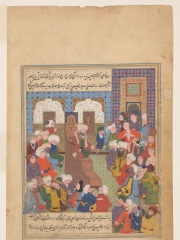
10. Junayd of Baghdad (830 - 910)
With an HPI of 71.53, Junayd of Baghdad is the 10th most famous Iraqi Religious Figure. His biography has been translated into 26 different languages.
Junayd of Baghdad (Persian: جُنیدِ بَغدادی; Arabic: الجنيد البغدادي; c. 830 – 910) was a mystic and one of the most famous of the early Islamic saints. He is a central figure in the spiritual lineage of many Sufi orders. Junayd taught in Baghdad throughout his lifetime and was an important figure in the development of Sufi doctrine. Like Hasan of Basra before him, was widely revered by his students and disciples as well as quoted by other mystics. Because of his importance in Sufi theology, Junayd was often referred to as the "Sultan".
People
Pantheon has 42 people classified as Iraqi religious figures born between 2038 BC and 1980. Of these 42, 5 (11.90%) of them are still alive today. The most famous living Iraqi religious figures include Louis Raphaël I Sako, Nahor, son of Terah, and Mullah Krekar. The most famous deceased Iraqi religious figures include Abraham, Abu Hanifa, and Sarah. As of April 2024, 2 new Iraqi religious figures have been added to Pantheon including Mari Emmanuel, and Murder of Du'a Khalil Aswad.
Living Iraqi Religious Figures
Go to all RankingsLouis Raphaël I Sako
1948 - Present
HPI: 70.61
Nahor, son of Terah
HPI: 61.46
Mullah Krekar
1956 - Present
HPI: 55.76
Mari Emmanuel
1970 - Present
HPI: 48.90
Bashar Warda
1969 - Present
HPI: 42.48
Deceased Iraqi Religious Figures
Go to all RankingsAbraham
1813 BC - 1638 BC
HPI: 89.99
Abu Hanifa
698 - 767
HPI: 83.39
Sarah
1803 BC - 1676 BC
HPI: 79.84
Rabia of Basra
710 - 801
HPI: 78.81
Mani
216 - 274
HPI: 78.43
Ezra
500 BC - 401 BC
HPI: 77.65
Muhammad al-Mahdi
869 - 941
HPI: 76.87
Belshazzar
600 BC - 600 BC
HPI: 75.54
Eber
2038 BC - 1574 BC
HPI: 74.57
Junayd of Baghdad
830 - 910
HPI: 71.53
Ibn Hisham
701 - 833
HPI: 70.58
Nahor, son of Serug
1912 BC - 1764 BC
HPI: 70.15
Newly Added Iraqi Religious Figures (2025)
Go to all RankingsOverlapping Lives
Which Religious Figures were alive at the same time? This visualization shows the lifespans of the 10 most globally memorable Religious Figures since 1700.

